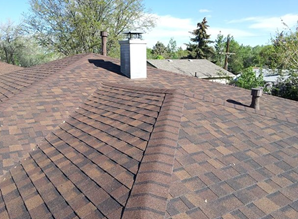
Roofing Inspection: How to Spot Hidden Problems
When it comes to maintaining your home, the roof is often one of the most overlooked areas. Yet, it’s one of the most critical components of your home’s structure. A well-maintained roof not only protects you from the elements but also helps in preserving the integrity and value of your property. Regular roofing inspections are essential to ensure that your roof remains in good condition and to catch any potential problems before they escalate. In this blog, we’ll walk you through how to spot hidden roofing issues and why a proactive approach can save you from costly repairs down the line.
The Importance of Regular Roofing Inspections
Your roof endures a relentless assault from the elements, including blistering heat, heavy rains, snow, and powerful winds. These harsh weather conditions gradually deteriorate roofing materials, leading to potential wear and tear that often goes unnoticed. Without regular inspections, minor issues can fester unnoticed, ultimately resulting in significant damage that could jeopardize the integrity of your home.
Proactively addressing roofing problems before they escalate not only helps in preserving the structural health of your home but also saves you from costly repairs. Regular inspections provide an opportunity to catch and resolve issues early, ensuring your roof continues to protect your home effectively and extending its lifespan.

Why Inspect Your Roof?
Preventative Maintenance
Regular roofing inspections are crucial for catching small issues before they escalate into larger, more costly problems. By identifying and addressing minor defects early, you can prevent them from becoming serious headaches. This proactive approach not only extends the lifespan of your roof but also saves you substantial repair costs over time.
Insurance and Warranty
Many insurance policies and roofing warranties mandate regular inspections to ensure coverage remains valid. Staying current with these inspections helps you adhere to policy requirements and avoid potential disputes. It also provides peace of mind, knowing that your roof is maintained in accordance with your insurance or warranty guidelines.
Energy Efficiency
A well-maintained roof plays a significant role in your home’s energy efficiency. Addressing issues such as missing shingles or damaged flashing helps improve insulation, which can lead to reduced energy costs. By maintaining your roof, you enhance your home’s ability to regulate temperature, ultimately saving money on heating and cooling bills.
Safety
A compromised roof can create serious safety hazards for your family. Issues like leaks, structural damage, or deteriorated materials can lead to dangerous problems such as mold growth or weakened structural integrity. Regular inspections help ensure your roof remains safe and secure, protecting your home and loved ones from potential harm.
How to Conduct a Roofing Inspection
Inspecting your roof doesn’t necessarily require a professional—though it’s always a good idea to have one if you’re unsure. Here’s a step-by-step guide to help you conduct a thorough inspection yourself:
Check for Visible Damage
Begin your inspection with a ground-level visual check. Using binoculars, closely examine your roof’s surface for any signs of damage. Look for missing, cracked, or curled shingles, as these can leave your roof exposed to the elements and lead to leaks. Additionally, note any granules in the gutters, which can signal shingle deterioration. Watch for blistering or buckling, often caused by improper installation or extreme heat, which may indicate underlying issues with your roofing materials.
Inspect the Roof’s Surface
If you can safely access your roof with a ladder, perform a more detailed inspection. Examine shingles for signs of wear such as curling, cracking, or granule loss. Check the metal flashing around chimneys, vents, and skylights to ensure it is intact and properly sealed. Roof valleys, where water collects and drains, should be clear of debris and in good condition to prevent water damage.
Examine the Gutters and Downspouts
Gutters are crucial for directing water away from your roof and foundation. Inspect them for clogs, which can result from accumulated leaves and debris, leading to overflow and potential roof damage. Ensure gutters are securely attached and level; sagging gutters can signal issues with supports or water damage that could impact roof performance and safety.
Look for Signs of Water Damage
Inside your home, check for indications of water damage that may point to roofing issues. Look for brown or discolored stains on ceilings, which can suggest leaks in the roof. Detect musty odors or visible mold growth, which might indicate moisture problems in the attic or roof space. If you have access, inspect the attic for signs of water infiltration or damage to the roof deck.
Evaluate Roof Structure
Assessing the structural integrity of your roof is essential for overall performance. Look for a sagging roofline, which can suggest underlying structural issues or damage. Inspect wooden components of the roof, such as the deck or rafters, for signs of rot. Rotting wood can weaken your roof’s structure and compromise its ability to protect your home effectively.
Common Roofing Problems to Watch For
Understanding common roofing problems can help you identify issues more quickly. Here are some typical issues you might encounter:
Leaks
Leaks are a prevalent roofing issue and can stem from several causes. Damaged shingles, whether missing or broken, can let water seep through. Improperly installed or sealed flashing around chimneys, vents, and skylights can also lead to leaks. Additionally, clogged gutters that overflow can cause water backup, resulting in roof damage.
Granule Loss
Granules on asphalt shingles protect them from UV rays and weathering. When these granules begin to wear away, it can indicate that the shingles are nearing the end of their useful life. This granule loss reduces the shingles’ effectiveness and exposes the underlying layers to potential damage.
Blistering and Buckling
Blistering occurs when air bubbles form under shingles due to excessive heat. This heat causes the adhesive to break down, leading to raised areas. Buckling can happen from improper installation or temperature fluctuations, creating a visually uneven surface that can compromise the roof’s integrity.
Moss and Algae Growth
Moss and algae growth often occurs in damp, shaded areas of a roof. Although these organisms may not cause immediate damage, they can accelerate roof deterioration over time. Moss holds moisture against the roof surface, potentially leading to further damage and decreased lifespan.
Roof Ventilation Issues
Proper roof ventilation is crucial for maintaining roof health. Poor ventilation can lead to excessive heat buildup, which damages roofing materials and shortens their lifespan. Inadequate ventilation can also result in condensation, causing moisture buildup that leads to mold growth and rot in the roof structure.
When to Call a Professional
While DIY inspections can be quite effective, there are situations where consulting a professional is essential. If you encounter significant damage, such as extensive shingle loss or structural issues, or if your roof is over 20 years old, a professional assessment becomes crucial. A roofing expert can provide a thorough evaluation and recommend appropriate repairs or replacements to ensure your roof remains reliable and safe.
Additionally, if you feel uncomfortable or unsafe climbing on your roof, it’s best to hire a professional. Roofing work can be hazardous, and experts have the necessary equipment and experience to handle it safely. For persistent issues like recurring leaks, a professional can accurately diagnose and address the underlying problems, ensuring a long-lasting solution.
Conclusion
Regular roofing inspections are crucial for maintaining the health and longevity of a roof. Proactively identifying and addressing issues such as leaks, granule loss, and ventilation problems can prevent minor concerns from escalating into major, costly repairs. While DIY inspections are valuable, it’s important to call in a professional when encountering significant damage, feeling unsafe performing inspections, or dealing with persistent problems. EZ Window Solutions of Beachwood provides expert roofing assessments and solutions to ensure that homes remain protected and in top condition. For a comprehensive roof inspection and to keep your roof in prime shape, contact EZ Window Solutions of Beachwood at (440) 773-4396.


Write a Comment